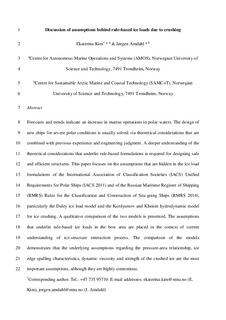| dc.contributor.author | Kim, Ekaterina | |
| dc.contributor.author | Amdahl, Jørgen | |
| dc.date.accessioned | 2017-11-09T07:58:57Z | |
| dc.date.available | 2017-11-09T07:58:57Z | |
| dc.date.created | 2015-11-02T08:36:22Z | |
| dc.date.issued | 2016 | |
| dc.identifier.citation | Ocean Engineering. 2016, 119 249-261. | nb_NO |
| dc.identifier.issn | 0029-8018 | |
| dc.identifier.uri | http://hdl.handle.net/11250/2465081 | |
| dc.description.abstract | Forecasts and trends indicate an increase in marine operations in polar waters. The design of new ships for severe polar conditions is usually solved via theoretical considerations that are combined with previous experience and engineering judgment. A deeper understanding of the theoretical considerations that underlie rule-based formulations is required for designing safe and efficient structures. This paper focuses on the assumptions that are hidden in the ice load formulations of the International Association of Classification Societies (IACS) Unified Requirements for Polar Ships (IACS, 2011) and of the Russian Maritime Register of Shipping (RMRS) Rules for the Classification and Construction of Sea-going Ships (RMRS, 2014), particularly the Daley ice load model and the Kurdyumov and Kheisin hydrodynamic model for ice crushing. A qualitative comparison of the two models is presented. The assumptions that underlie rule-based ice loads in the bow area are placed in the context of current understanding of ice–structure interaction process. The comparison of the models demonstrates that the underlying assumptions regarding the pressure–area relationship, ice edge spalling characteristics, dynamic viscosity and strength of the crushed ice are the most important assumptions, although they are highly contentious. | nb_NO |
| dc.language.iso | eng | nb_NO |
| dc.publisher | Elsevier | nb_NO |
| dc.rights | Attribution-NonCommercial-NoDerivatives 4.0 Internasjonal | * |
| dc.rights.uri | http://creativecommons.org/licenses/by-nc-nd/4.0/deed.no | * |
| dc.title | Discussion of assumptions behind rule-based ice loads due to crushing | nb_NO |
| dc.type | Journal article | nb_NO |
| dc.type | Peer reviewed | nb_NO |
| dc.description.version | acceptedVersion | nb_NO |
| dc.source.pagenumber | 249-261 | nb_NO |
| dc.source.volume | 119 | nb_NO |
| dc.source.journal | Ocean Engineering | nb_NO |
| dc.identifier.doi | 10.1016/j.oceaneng.2015.09.034 | |
| dc.identifier.cristin | 1285196 | |
| dc.relation.project | Norges forskningsråd: 223254 | nb_NO |
| dc.relation.project | Norges forskningsråd: 203471 | nb_NO |
| dc.description.localcode | © 2015. This is the authors’ accepted and refereed manuscript to the article. This manuscript version is made available under the CC-BY-NC-ND 4.0 license http://creativecommons.org/licenses/by-nc-nd/4.0/ | nb_NO |
| cristin.unitcode | 194,64,20,0 | |
| cristin.unitcode | 194,64,91,0 | |
| cristin.unitname | Institutt for marin teknikk | |
| cristin.unitname | Institutt for bygg- og miljøteknikk | |
| cristin.ispublished | true | |
| cristin.fulltext | postprint | |
| cristin.qualitycode | 1 | |

